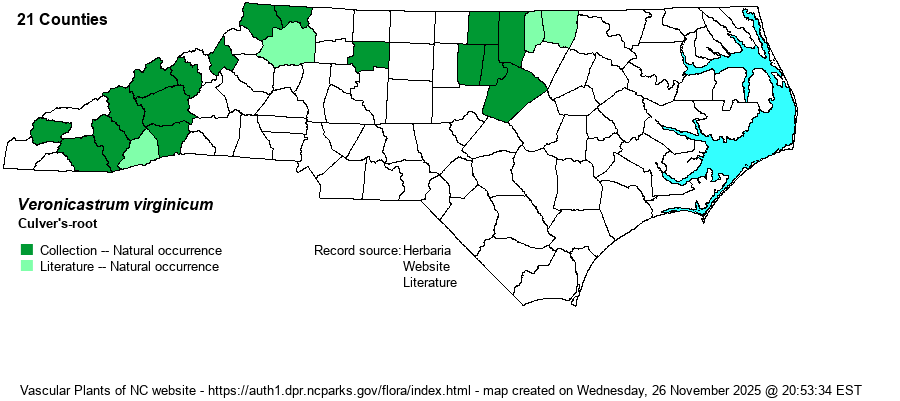| Author | (L.) Farwell | |
| Distribution | A split range in the state: found essentially over the Mountains, and also only in the northeastern Piedmont (south to Wake County). Only a single northern Piedmont record (Forsyth County) between these two areas.
This is a Northern and Midwestern species, found from eastern Canada south to NC, central AL, and barely to TX. | |
| Abundance | Rare in the Mountains and in the northeastern Piedmont; extremely rare between these areas, in the northern Piedmont. This is a Watch List species, though being conspicuous, it should be W1 (rare but relatively secure) as opposed to W7 (rare and poorly known); it could even be given a Significantly Rare status. The State Rank needs no "?" and it should simply be at S2. | |
| Habitat | This species has some fairly particular requirements; some moisture with a somewhat high pH soil. It grows in certain bogs or wet meadows, stream banks, seepage areas along woodland edges or in powerline clearings, or somewhat moist places in glade-like open woods. It can grow in dry soil, but if so only where the soil is high pH, as it does grow in prairies farther to the west of the state. | |
| Phenology | Blooms in July and August, and fruits shortly after flowering. | |
| Identification | This is a striking and stately plant, one of the more easily identified "scrophs" in the state. From the ground to the tip of the flowering stalk it can reach 4 feet high or more. It has numerous whorls of leaves, generally 3-7 in a whorl, and each is lanceolate and about 4 inches long and about 3/4-inch wide, with serrated margins. It might look a bit like a Joe-pye-weed (Eutrochium spp.) in leaf, but when in flower, all doubt is erased. At the end of the stem is a very long spike of small white flowers; this spike is often 6 inches tall; and there are often several other spikes in a whorl just below the terminal one, all erect, such that it looks like a bush decorated with long white candles! This plant can easily be spotted when you are driving at full speed down a road, but sadly there are few places in the state where you will be able to do that. | |
| Taxonomic Comments | None
| |
| Other Common Name(s) | None | |
| State Rank | S2? [S2] | |
| Global Rank | G4 | |
| State Status | W7 [W1] | |
| US Status | | |
| USACE-agcp | FACW link |
| USACE-emp | FACU link |

